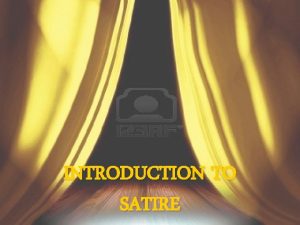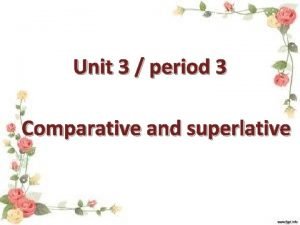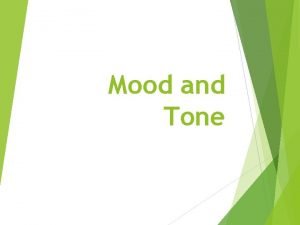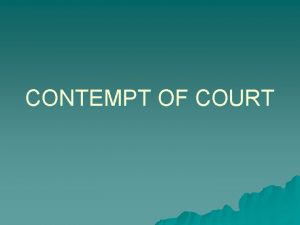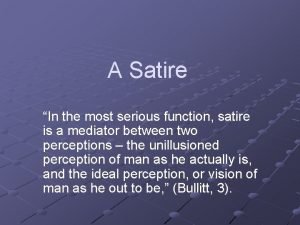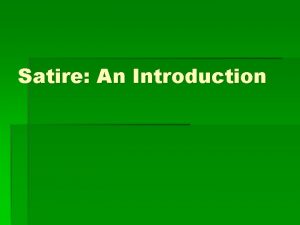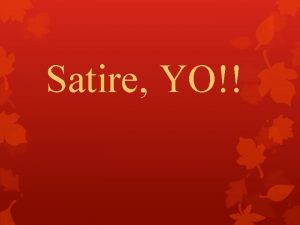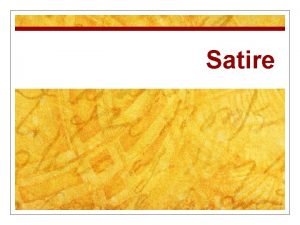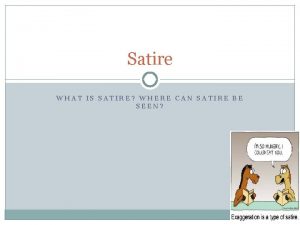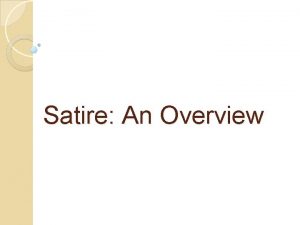Satire Even lighthearted satire has a serious aftertaste










- Slides: 10

Satire Even light-hearted satire has a serious after-taste: "first make people laugh, and then make them think. "

Definition of Satire A genre in which vices, follies, abuses, and shortcomings are held up to ridicule, or scorn, ideally with the intent of shaming individuals, groups and/or society itself, into improvement.

The Many Faces of Satire Saturday Night Live The Daily Show The Colbert Report Shrek The Onion Austin Powers Most political cartoons in newspapers and magazines • Weird Al Yankovic’s music • •

Satire is… …usually meant to be funny, but its greater purpose is often to criticize some aspect of society, using wit as a weapon to attack that shortcoming. …commonly characterized by sarcasm & irony: » Sarcasm--sharp and often satirical or ironic utterance designed to cut or give pain “I am not young enough to know everything. ” “Marriage is the chief cause of divorce. ” » Irony--the use of words to express something other than and especially the opposite of the literal meaning

Verbal Irony is when a speaker says one thing, but means another. NOT sarcasm! Oh, yesss! I LOVE rotten cheese : D Dramatic Irony is when an event occurs whose significance is understood by the audience and not the characters. Audience knows more than the characters. Situational Irony is when something happens and a reversal of expectations occurs. This one can get tricky, however…

Literary Terms to Know for Unit: Allegory: An allegory is a story with (count 'em) two levels of meaning. First, there's the surface of the story. You know, the characters and plot and all that obvious stuff. Then there's the symbolic level, or the deeper meaning that all the jazz on the surface represents. Allusion: An allusion is a figure of speech that refers to a well-known story, event, person, or object in order to make a comparison in the readers' minds. Symbol: a symbol is a word, an image, or anything that somehow represents a larger idea.

Methods of Satire Exaggeration To enlarge, increase, or represent something beyond normal bounds so that it becomes ridiculous and its faults can be seen. Juxtaposition the act of placing two or more opposite/unalike things side by side; to add contrast Analogy A comparison between two things, typically on the basis of their structure and for the purpose of explanation or clarification. Double entendre ambiguity of meaning arising from language that lends itself to more than one interpretation; or a word or expression capable of two interpretations with one usually being risqué

Modes of Satire Parody— A humorous imitation of style, characters, or subject matter of serious writing. Parody is designed to ridicule a work or to point out, or exaggerate its characteristics. Spoof—Used to make fun or mock someone or something by imitating them in a funny or satirical way. Imitate (something) while exaggerating its characteristic features for comic effect: "“Scary Movie” spoofs horror movies". Caricature—A humorous picture that exaggerates or distorts certain qualities in order to create a ridiculous effect. Its true intent is not to criticize just one individual, but rather to ridicule an entire societal group or social practice. Mock-Heroic—Ridiculing or burlesquing (grotesque exaggeration or comic imitation) heroic style, character, or action Lampooning—A harsh attack on an individual. It can be written, or in the form of a drawing. In the early years of the United States, political lampoons were both common and vicious. Our own political cartoons can be seen as lampoons.

Two Classifications of Satire: • Horatian satire, named for the Roman satirist Horace (65 – 8 BCE), playfully criticizes some social vice through gentle, mild, and light-hearted humour. It directs wit, exaggeration, and selfdeprecating humour toward what it identifies as folly, rather than evil. – Makes you laugh, thoughtful reflection is the aftertaste. • Juvenalian satire, named after the Roman satirist Juvenal (late 1 st century – early 2 nd century CE), is more contemptuous and abrasive and addresses social evil through scorn, outrage, and savage ridicule. This form is often pessimistic, characterized by irony, sarcasm and moral indignation with less emphasis on humor. – Makes you feel a knot in your stomach at first, the aftertaste you’re left with makes you want to change your evil ways, or the evils ways of others.

Review • What is satire? • What are the two primary classifications or satire? • What are the modes of Satire? • What methods might an author employ when writing a satire?



